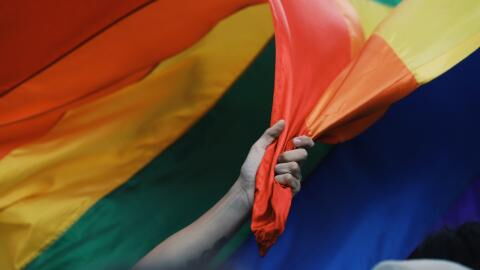It's one of the most recognizable symbols of the gay, lesbian, bi, trans and, more generally, queer community. Of course, we are talking about the rainbow flag, which is bringing out a lot of colours during this pride month!
Discover our latest podcast
Some of you might wonder what queer really means, and we can give you a simple definition. A queer person is someone who does not recognize themselves in society's 'classic' models of gender or sexual orientation. We have all seen the rainbow flag waving around lately, but do you know its origin story?
Gilbert Baker was an artist and gay activist
The rainbow flag, or 'pride flag', dates back to 1978. It was created by Gilbert Baker, an openly gay artist and drag queen, who, at the request of Harvey Milk, the famous American politician and gay rights activist, created the flag to embody the pride of the gay community, at a time when it was still considered as shameful. Homosexuality stopped being considered as a mental illness in the US in 1973, but it was still considered a 'deviance' until 1987, according to Psychology Today.
We recommend you watch the excellent biopic starring Sean Penn as the first openly gay elected official in California's history.
Read more:Miriam Margolyes' unconventional 54-year relationship: Who is Heather Sutherland?
'This is who I am'
Let's get back to the flag. Regarding the choice of colours, Baker explained in an interview that the flag was a symbol of visibility and pride for queer people.
Our task as homosexuals was to show ourselves, to be visible, to live in the truth, as I said, to come out of the lie. A flag really fits this mission, because it's a way of proclaiming one's visibility or saying 'This is who I am'.
For the colours, Gilbert Baker explained that he drew inspiration from several sources. In tune with the other struggles and issues of his time, Baker was also a supporter of the civil rights movement. Naturally, he was inspired by the 'race flag' used on American university campuses in the 1960s. This featured five bands of color: red, black, brown, yellow and white.
According to Readers Digest, Baker also drew his inspiration from the famous song Over the Rainbow, sung by Judy Garland, one of the very first gay icons. Baker said he had the help of 30 friends to sew the 8 bands of colour.
This 2023 is the 45th anniversary of the Rainbow flag which was first designed and sewn by US Army veteran Gilbert Baker. The flag was first flown on June 25, 1978 at the San Francisco #Pride March.
— Tonyo Cruz (@tonyocruz) June 1, 2023
(Photo from LA Times) pic.twitter.com/8lxFceokuz
Read more:Chris Evans labels homophobes 'idiots' after backlash for Disney LGBTQ+ scene
The colours of the rainbow
Each colour of the rainbow flag has got its own meaning. Pink stands for sex, red is for life, orange represents healing, yellow for sunlight, green symbolizes nature, turquoise is for magic and art, blue is a sign of serenity and harmony and purple is for the spirit.
But as you may have noticed, we're now down to 6 color bands, 2 less than the original 8! In fact, it's been modified for a number of reasons.
Firstly, for economic reasons, pink being more complex to produce at affordable costs, but also for reasons of parity. The turquoise color has been eliminated in favor of a flag with an even number of stripes.
Read more:Younger people are identifying as LGBTQIA+ more than even before
This article has been translated from Gentside FR.
Sources used:
Psychology Today: When Homosexuality Stopped Being a Mental Disorder
Readers Digest: How the Rainbow Became the Symbol for LGBTQ+ Pride
Making Queer History: Gilbert Baker & the Rainbow Flag















